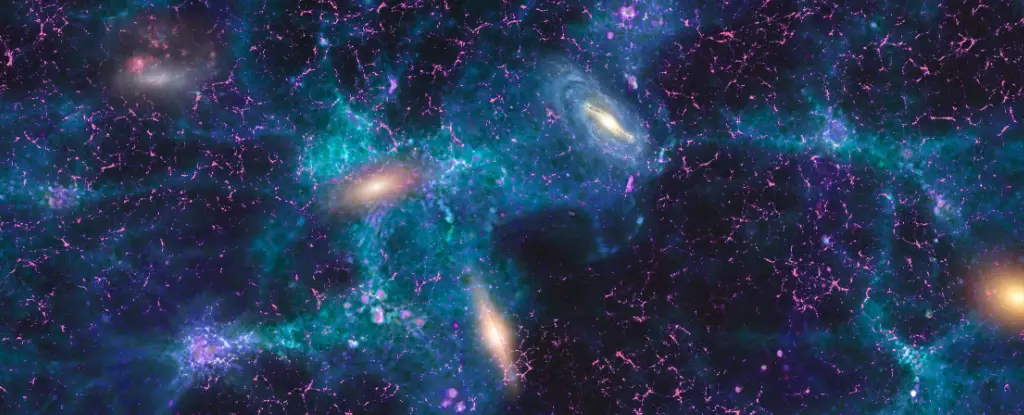In recent years, the field of cosmology has encountered a perplexing phenomenon: the expansion of the universe seems to be accelerating at a pace that confounds our best scientific understanding. Researchers have delved into this cosmic conundrum, focusing on measurements taken from a distant galaxy cluster located approximately 320 million light-years from Earth. This research has unveiled a troubling inconsistency in the calculations related to the rate of expansion, known as the Hubble constant, demonstrating that our current models may no longer suffice to explain the observable universe.
The Hubble constant serves as a crucial aspect of contemporary cosmological models, offering insight into how quickly galaxies are receding from one another. For about a century, astronomers have grappled with the implications of an ever-expanding cosmos—one that emerged from the dense, hot state commonly referred to as the Big Bang. Nonetheless, recent discoveries demonstrate that different methodologies yield varying results in determining the Hubble constant, posing significant challenges to our understanding of cosmic evolution.
Observations conducted using diverse techniques, such as measuring the distances to galaxies through standard candles like Type Ia supernovae (exploding stars with consistent luminosities) or the cosmic microwave background radiation from the universe’s infancy, have generated distinctly different values for the expansion rate. Whereas estimates derived from supernovae suggest a rate of 76.5 kilometers per second per megaparsec, measurements linked to the cosmic microwave background reveal a much slower expansion of 67.4 kilometers per second per megaparsec. This disparity reflects what has been described as the “tension” in cosmological measurements, a situation that several experts assert has reached a crisis point.
A focal point in resolving this discrepancy lies in the work led by physicist Dan Scolnic from Duke University. His team utilized data from the Dark Energy Spectroscopic Instrument (DESI) to produce high-precision measurements of a galaxy cluster. The Coma cluster, home to over 1,000 galaxies, became a testing ground for validating the existing distance calculation methods. By painstakingly investigating the spectral emissions from the galaxies, Scolnic and his team managed to unlock critical insights about their distances.
Employing a method that matched these emissions to those of individual Type Ia supernovae, the researchers established a distance of approximately 321 million light-years for the Coma cluster. This validation of distance measurement is paramount, as it allows for better estimates of the universe’s expansion and draws new connections to similar cosmic observations.
Finding a reliable distance to celestial bodies can significantly impact our broader understanding of cosmic expansion. A consistent measurement reinforces our confidence in calculating the Hubble constant, leading to a more coherent theoretical framework. However, the prevailing dilemma remains: the remarkable difference between the results from different measuring techniques persists, indicating a complex underlying phenomenon. Some researchers suggest this discrepancy may point to a deeper misunderstanding of fundamental physics, potentially suggesting new realms of material or energy beyond our established models.
With the current exploration at the frontier of cosmology, Scolnic underscores the pressing need to reconsider existing models that have guided scientific thought for decades. The divergence in measurements is proving so profound that it could reshape our entire understanding of the universe and its dynamics. As scientists probe further into these cosmic mysteries, they are not merely answering questions about the universe’s expansion; they are challenging the foundational principles of physics that govern our comprehension of reality.
As researchers forge ahead, the pursuit of answers will involve refining the methods used to gauge the universe’s expansion. Collaborations and technological advancements, such as improved observational equipment and analytical techniques, will undoubtedly play a vital role in this scientific endeavor. The ultimate goal is twofold: first, to uncover any miscalculations or assumptions that could reconsolidate our understanding, and second, to potentially discover new aspects of the universe that herald groundbreaking scientific revelations.
As we continue to grapple with the complexities of the expanding universe, the inherent tensions provide an exciting intellectual challenge. They beckon us to investigate further and refine our comprehension of the cosmos. The questions raised from the research surrounding the Hubble constant echo through the halls of scientific inquiry, underscoring an essential truth: the quest to understand our universe is ever-evolving and, above all, intrinsically fascinating.

